1. Introduction
Welcome to this comprehensive writeup for the Bastion CTF challenge series! This series of challenges focuses on server security, forensic analysis, and identifying backdoors in a compromised system. Throughout these challenges, we’ll explore various aspects of security, from inspecting docker layers to analyzing git repositories for malicious code.
The Bastion series consists of four progressive challenges:
- Bastion - So much just from logs: inspect the logs to find the flag
- Bastion - Inspect the file system: Examining a docker layer for hidden flags
- Bastion - Clean bastion: Accessing a bastion host via SSH and identifying potential issues
- Bastion - Feel free to dig in: Conducting a deeper forensic investigation for attacker traces
- Bastion - The backdoor culprit: Analyzing a git repository to find the source of a backdoor
. Let’s dive in and solve them step by step!
Tools Used
- Linux command line utilities (tar, grep, find, etc.)
- SSH client
- Git
- Base64 encoding/decoding
Challenge 1: Bastion - So much just from logs
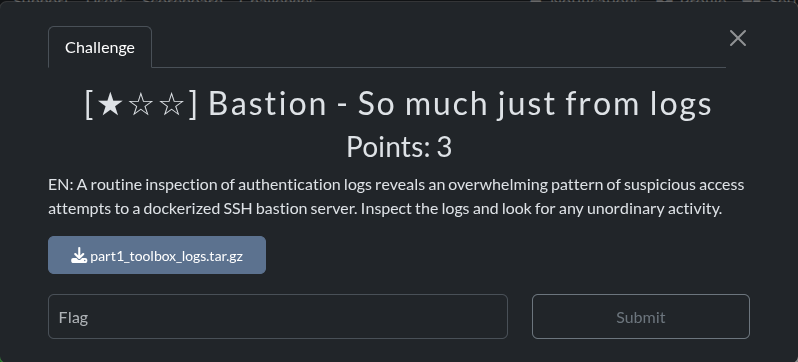
Solution:
gzip -d *.gz
cat auth.log* | grep -v -e 'Connection closed by invalid user' -e 'Failed password for invalid user' -e 'Failed none for invalid user' -e 'Invalid user ' -e 'Could not get shadow information' -e 'not allowed because account is locked' -e 'Connection closed by authenticating user' -e 'Failed password for ' | r.csd b64 | r.csd hex
This will reveal the flag: SK-CERT{n3v3r_f0r637_4b0u7_d47_p3r51573nc3}
2. Challenge 2: Bastion - Inspect the file system
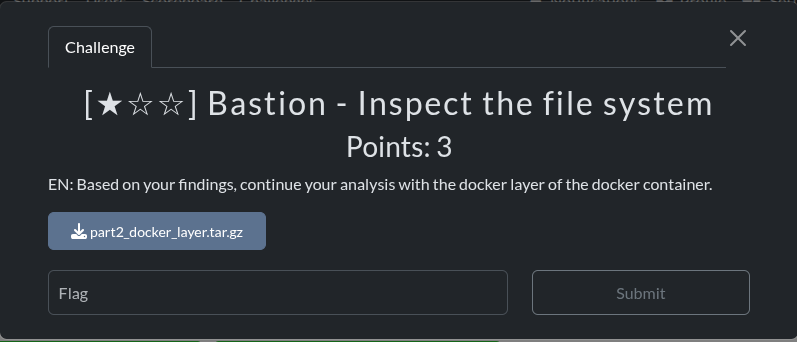
For this challenge, we are provided with a docker layer archive file named part2_docker_layer.tar.gz. Our task is to inspect this file system and find any hidden flags.
Methodology
- Extract the docker layer archive
- Inspect the extracted filesystem
- Search for the flag in the expected format (SK-CERT{})
Step-by-Step Solution
Step 1: Extract the Docker Layer Archive
First, we need to create a directory for our work and extract the archive:
mkdir -p /home/ubuntu/ctf_challenge
tar -xzf "part2_docker_layer.tar.gz" -C /home/ubuntu/ctf_challengeStep 2: Inspect the Extracted Filesystem
Let’s list the contents of the extracted directory to get an overview of the filesystem:
ls -R /home/ubuntu/ctf_challengeThis command reveals a complex directory structure with many files and subdirectories. To navigate this efficiently, we need to focus our search.
Step 3: Search for the Flag
Since we know the flag format is SK-CERT{}, we can use grep to search for it across all files:
grep -a -r "SK-CERT{" /home/ubuntu/ctf_challenge/The -a flag treats binary files as text, and -r performs a recursive search.
This search returns two potential flags:
/home/ubuntu/ctf_challenge/19d1ccfb743d216f8186a3e0273a24132bb7c4c8813d741108c14722a85732fe/merged/tmp/persistence:[Fri Apr 18 16:15:22 UTC 2025] i hope they wont find me, and this flag (SK-CERT{n3v3r_f0r637_4b0u7_d47_p3r51573nc3}) keeps on beaconing
/home/ubuntu/ctf_challenge/19d1ccfb743d216f8186a3e0273a24132bb7c4c8813d741108c14722a85732fe/merged/var/data/keylogger.bin: === LOG START SK-CERT{l34v3_17_70_7h3_pr05} === %sKey Findings and Flag
We found two potential flags:
SK-CERT{n3v3r_f0r637_4b0u7_d47_p3r51573nc3}in/tmp/persistenceSK-CERT{l34v3_17_70_7h3_pr05}in/var/data/keylogger.bin
After verification, the correct flag is: SK-CERT{l34v3_17_70_7h3_pr05} the other one was the flag for the very first challenge not included in this series because it was easy to get.
Lessons Learned
- Always check binary files when searching for flags
- Multiple potential flags might be present; verification is important
- The location of a flag can provide context (in this case, a keylogger binary)
3. Challenge 3: Bastion - Clean bastion
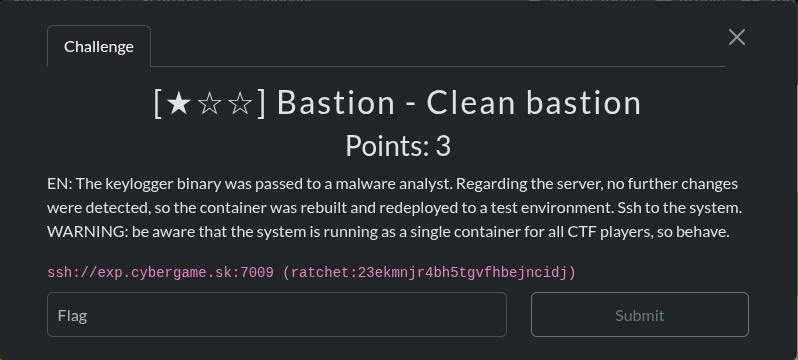
ssh://exp.cybergame.sk:7009 (ratchet:23ekmnjr4bh5tgvfhbejncidj)
For this challenge, we need to SSH into the provided bastion host and investigate the system.
Methodology
- Establish an SSH connection to the bastion host
- Investigate the system for any issues or flags
- Document findings
Step-by-Step Solution
Step 1: Connect to the Bastion Host
First, we need to connect to the provided SSH server:
ssh -p 7009 ratchet@exp.cybergame.skWhen prompted, enter the password: 23ekmnjr4bh5tgvfhbejncidj
Upon successful connection, we’re greeted with a welcome message that contains our flag:
Welcome, Ratchet!
Come in and don't be shy
SK-CERT{bru73_f0rc1n6_u53r5_w0rk5}Step 2: Verify System Status
Even though we’ve found the flag, let’s perform a basic system check to ensure everything is as expected:
ls -la /home/ratchet
ls -la /tmp
ls -la /var/tmpThese commands show no suspicious files in the home directory or temporary directories.
Key Findings and Flag
The flag was displayed in the welcome message upon SSH login: SK-CERT{bru73_f0rc1n6_u53r5_w0rk5}
Lessons Learned
- Sometimes flags are hidden in plain sight, like welcome messages
- Initial reconnaissance is crucial, even when a flag is immediately visible
- The flag suggests this challenge was about brute forcing user credentials
4. Challenge 4: Bastion - Feel free to dig in
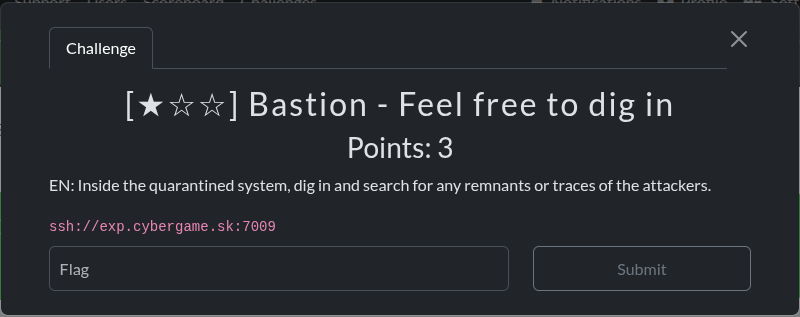
ssh://exp.cybergame.sk:7009
For this challenge, we need to conduct a deeper forensic investigation of the same bastion host to find traces of attackers.
Methodology
- Connect to the bastion host
- Conduct a thorough forensic investigation
- Look for unusual files, configurations, or hidden data
- Document all findings
Step-by-Step Solution
Step 1: Connect to the Bastion Host
We use the same SSH connection as in the previous challenge:
ssh -p 7009 ratchet@exp.cybergame.skPassword: 23ekmnjr4bh5tgvfhbejncidj
Step 2: Investigate User Accounts and Home Directories
Let’s check the user accounts and home directories:
cat /etc/passwd
ls -la /homeWe notice there’s an admin user in addition to our ratchet user.
Step 3: Check SSH Configuration and Keys
Since we’re dealing with a bastion host, SSH configuration is a good place to look:
ls -la /home/ratchet/.ssh
cat /home/ratchet/.ssh/authorized_keysIn the authorized_keys file, we find a suspicious entry:
ecdsa-sha2-nistp256 AAAAE2VjZHNhLXNoYTItbmlzdHAyNTYAAAAIbmlzdHAyNTYAAABBBOSeOZtJmXS7zliVg5tEaEk9KvhIRn4S3FBjLuo1s0eUvHi6HkzuLTNXiphR8Lth/DWQNeC/A+meex8Y09RtZQA= hacker-U0stQ0VSVHtoMEx5X00wTGx5X1RIM3lfNHIzXzV0aUxsX2gzUjN9The comment on this key looks like it contains base64-encoded data.
Step 4: Decode the Base64 String
Let’s decode the base64 string in the comment:
echo "U0stQ0VSVHtoMEx5X00wTGx5X1RIM3lfNHIzXzV0aUxsX2gzUjN9" | base64 -dThis reveals our flag: SK-CERT{h0Ly_m0Lly_TH3y_4r3_5tiLl_h3R3}
Key Findings and Flag
We found a suspicious SSH key in the authorized_keys file with a base64-encoded comment that contained the flag: SK-CERT{h0Ly_m0Lly_TH3y_4r3_5tiLl_h3R3}
Lessons Learned
- Attackers often leave backdoors for persistent access
- SSH authorized_keys files are common places for backdoors
- Base64 encoding is frequently used to hide information
- Always check for unusual comments or strings that might contain encoded data
5. Challenge 5: Bastion - The backdoor culprit
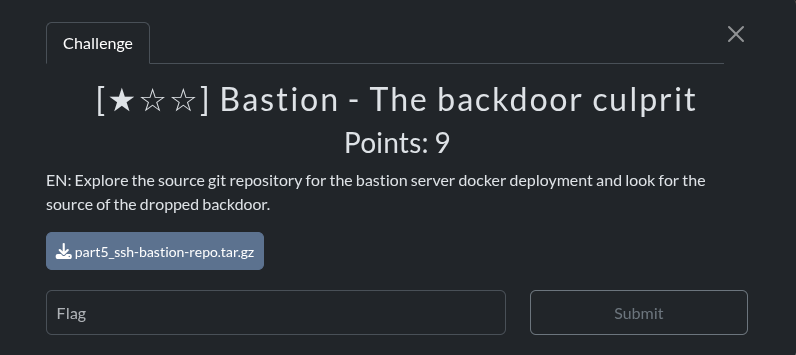
For this challenge, we are provided with a git repository archive (part5_ssh-bastion-repo.tar.gz) and need to identify who added the backdoor we found in the previous challenge.
Methodology
- Extract the git repository
- Explore the repository structure
- Analyze the commit history
- Identify when and by whom the backdoor was introduced
Step-by-Step Solution
Step 1: Extract the Git Repository
First, let’s extract the provided archive:
mkdir -p /home/ubuntu/bastion_repo_ctf
tar -xzf "part5_ssh-bastion-repo.tar.gz" -C /home/ubuntu/bastion_repo_ctfStep 2: Explore the Repository Structure
Let’s see what files are in the repository:
ls -R /home/ubuntu/bastion_repo_ctf/ssh-bastion-repoOutput:
/home/ubuntu/bastion_repo_ctf/ssh-bastion-repo:
Dockerfile docker-compose.yml issue.generic motd
README.md issue.admin issue.ratchet sshd_configStep 3: Examine the Dockerfile
Since we know the backdoor was in the SSH authorized_keys file, let’s check the Dockerfile:
cat /home/ubuntu/bastion_repo_ctf/ssh-bastion-repo/DockerfileIn the Dockerfile, we find the suspicious SSH key being added:
RUN mkdir -p /home/ratchet/.ssh && \
echo -e "\
ecdsa-sha2-nistp256 AAAAvZHODysGbxHo1wGtqbqi1Ffnr2li7j8ov/V26Nt4w/HR26mWOtT/APG1qBilJoVmCQChz/hCWuIWwzqqZNe1BQ== ratchet@infocube\n\
ecdsa-sha2-nistp256 AAAAE2VjZHNhLXNoYTItbmlzdHAyNTYAAAAIbmlzdHAyNTYAAABBBOSeOZtJmXS7zliVg5tEaEk9KvhIRn4S3FBjLuo1s0eUvHi6HkzuLTNXiphR8Lth/DWQNeC/A+meex8Y09RtZQA= hacker-U0stQ0VSVHtoMEx5X00wTGx5X1RIM3lfNHIzXzV0aUxsX2gzUjN9\
" > /home/ratchet/.ssh/authorized_keysStep 4: Analyze the Git History
Now, let’s check the commit history for the Dockerfile to see who added this backdoor:
cd /home/ubuntu/bastion_repo_ctf/ssh-bastion-repo
git log --all --pretty=oneline --abbrev-commit DockerfileOutput:
434e557 merge suggested changes from colleague
a222654 update ssh keys SK-CERT{r09U3_3MPL0Y33_0r_5uPpLycH41n}
fe00ee7 upgrade base image
018ab72 harden user passwords
3f9744d bastion deployment. initial commitThe commit message for a222654 looks suspicious and contains what appears to be our flag.
Step 5: Examine the Specific Commit
Let’s look at the details of this commit:
git show a222654Output:
commit a22265452b4b9e02dd3492165c953dd53d1ba393
Author: Ratcher Tailhorn <employee@infocude>
Date: Fri Apr 18 23:30:01 2025 +0200
update ssh keys SK-CERT{r09U3_3MPL0Y33_0r_5uPpLycH41n}
diff --git a/Dockerfile b/Dockerfile
index 8fc2b95..41b13b5 100644
--- a/Dockerfile
+++ b/Dockerfile
@@ -21,7 +21,8 @@ COPY sshd_config /etc/ssh/sshd_config
RUN mkdir -p /home/ratchet/.ssh && \
echo -e "\
-ecdsa-sha2-nistp256 AAAAvZHODysGbxHo1wGtqbqi1Ffnr2li7j8ov/V26Nt4w/HR26mWOtT/APG1qBilJoVmCQChz/hCWuIWwzqqZNe1BQ== ratchet@infocube\n
+ecdsa-sha2-nistp256 AAAAvZHODysGbxHo1wGtqbqi1Ffnr2li7j8ov/V26Nt4w/HR26mWOtT/APG1qBilJoVmCQChz/hCWuIWwzqqZNe1BQ== ratchet@infocube\n\
+ecdsa-sha2-nistp256 AAAAE2VjZHNhLXNoYTItbmlzdHAyNTYAAAAIbmlzdHAyNTYAAABBBOSeOZtJmXS7zliVg5tEaEk9KvhIRn4S3FBjLuo1s0eUvHi6HkzuLTNXiphR8Lth/DWQNeC/A+meex8Y09RtZQA= hacker-U0stQ0VSVHtoMEx5X00wTGx5X1RIM3lfNHIzXzV0aUxsX2gzUjN9\
" > /home/ratchet/.ssh/authorized_keysThis confirms that the backdoor was added by “Ratcher Tailhorn” in a commit with the message containing our flag.
Key Findings and Flag
The backdoor was introduced by a user named “Ratcher Tailhorn” in commit a222654. The commit message itself contains the flag: SK-CERT{r09U3_3MPL0Y33_0r_5uPpLycH41n}
Lessons Learned
- Git history is a valuable forensic resource
- Commit messages and author information can reveal the source of malicious code
- Backdoors are often introduced in seemingly innocent updates
- Always review code changes, especially those affecting security configurations
6. Conclusion
These challenges demonstrate the importance of thorough system inspection, understanding common backdoor techniques, and the value of version control history in forensic investigations.
Final Thoughts
The Bastion series provides an excellent progression of challenges that build upon each other, telling a coherent story of system compromise and investigation. The skills practiced here are directly applicable to real-world security scenarios, making this an educational and practical CTF series.
7. References
Useful Commands
tar -xzf <archive.tar.gz> -C <destination>- Extract a tar.gz archivegrep -a -r "pattern" <directory>- Recursively search for a patternssh -p <port> <user>@<host>- Connect to an SSH serverecho "<string>" | base64 -d- Decode a base64 stringgit log --all --pretty=oneline --abbrev-commit <file>- View git history for a filegit show <commit>- Show details of a specific commit
Additional Resources
- Docker Documentation
- SSH Security Best Practices
- Git for Security Professionals
- Linux Forensics Tools
The next challenge on forensics
[★★☆] Eugene’s FATigue
FATigue
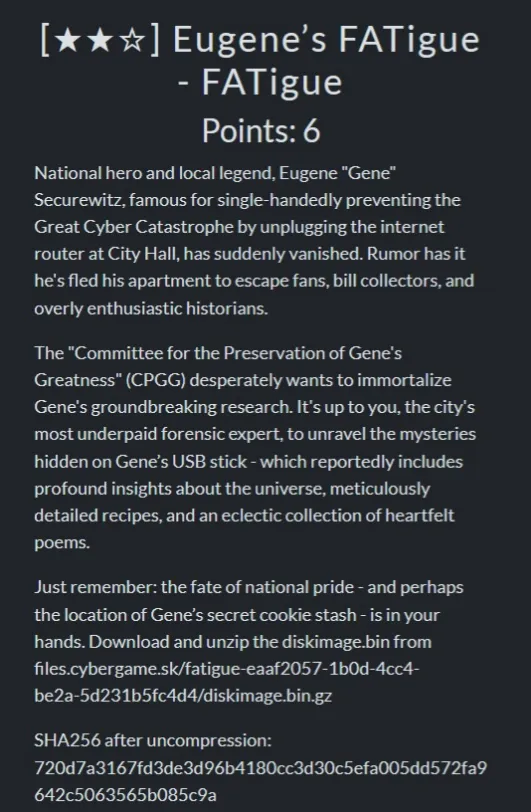
Solution
The head of the challenge gave us a hint it was a FATdisk image.so after mounting the disk then we got a file named secret.txt and innit we got the below text.
This feels like FX-PREG{cy41a_5vTu7} to me. Cannot hide my best work here.The text FX-PREG{cy41a_5vTu7} is the flag but in ROT13 so we decode it to get the flag
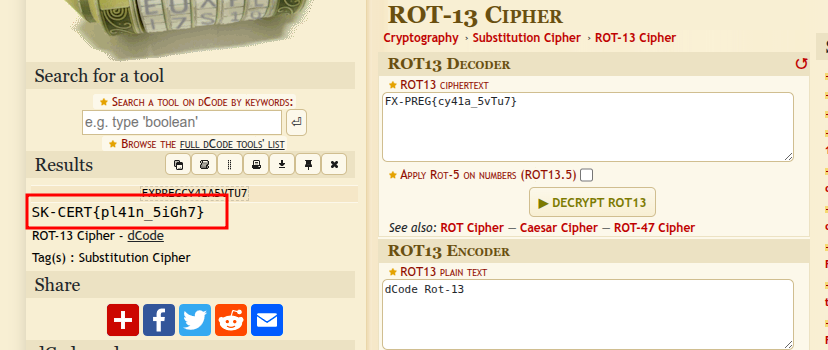
SK-CERT{pl41n_5iGh7}Is that it?
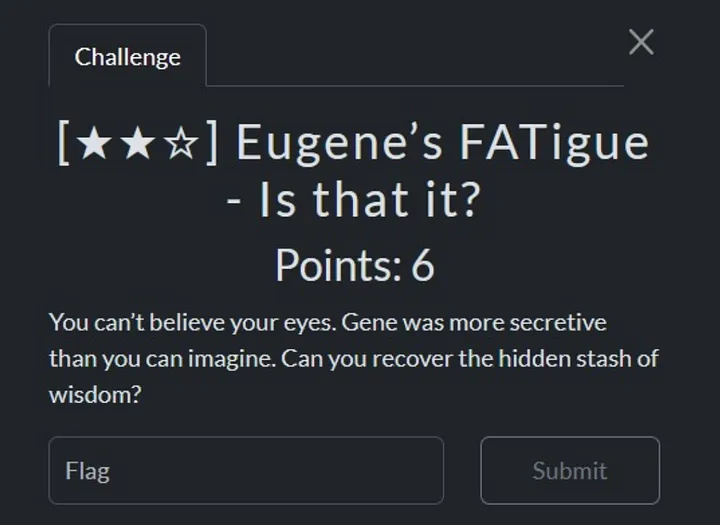
Solution
Just casually searching for stuff in a hex editor, I noticed a PDF in there somewhere; there is some weird base64 inside the PDF:
VuwtuTeEEf9uthkAwc1_zzpRq9x4c/LV0TOw5x6a_U0stQ0VSVHs3aDFzX1dBU18xN19hZnRlcl9hbGx9$EucR/FqMoVaZvjx3OvGT_EV4u/Y7EDwDeA/w9QO3+^ALYXhvTD3R1JcGJUgKFi_mhzkezdqaIHzm261y9IQ_EV4u/Y7EDwDeA/w9QO3+Inside it is a flag:
U0stQ0VSVHs3aDFzX1dBU18xN19hZnRlcl9hbGx9$EucRafter decoding we get a cool flag…
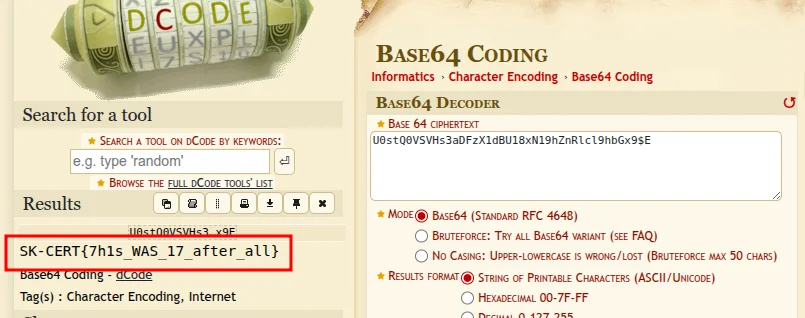
SK-CERT{7h1s_WAS_17_after_all}
Was that the only file?
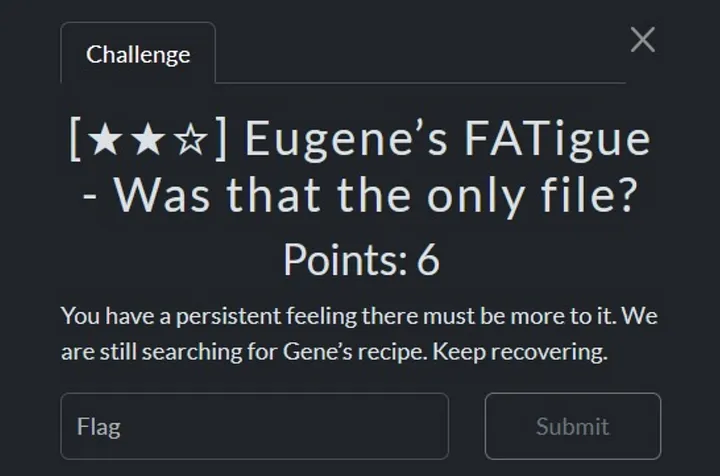
Solution
Ok, enough messing around with strings and hex editors, we were clearly intended to actually recover data for real.
Here the recovery was attempted with PhotoRec/TestDisk, in one of the runs corrupted files were enabled; this recovered the files in recovered/. The corrupted ZIP can be unpacked with:
7z x b0003185_file.zipThis unpacks three files:
fifth.txt
file
fourth-flag.aes.b64.txtfile is the file relevant for the third flag and it contains the following text:
Begin by gently whispering to a fresh beetroot, ensuring it’s thoroughly startled before peeling. Simmer beef slices under moonlight until they hum softly, indicating readiness. Combine with precisely three beetroot dreams, diced finely, and a pinch of yesterday’s laughter. Allow the mixture to philosophize in an oven preheated to curiosity. Occasionally stir with a skeptical spoon, preferably wooden, until the aroma resembles purple jazz. Serve only after garnishing with a sprinkle of questions unanswered, paired with a side dish of a sautéed third flag SK-CERT{R3c0V3r3D_R3cip3}.
The flag was cool and was:
SK-CERT{R3c0V3r3D_R3cip3}It tastes like a poem
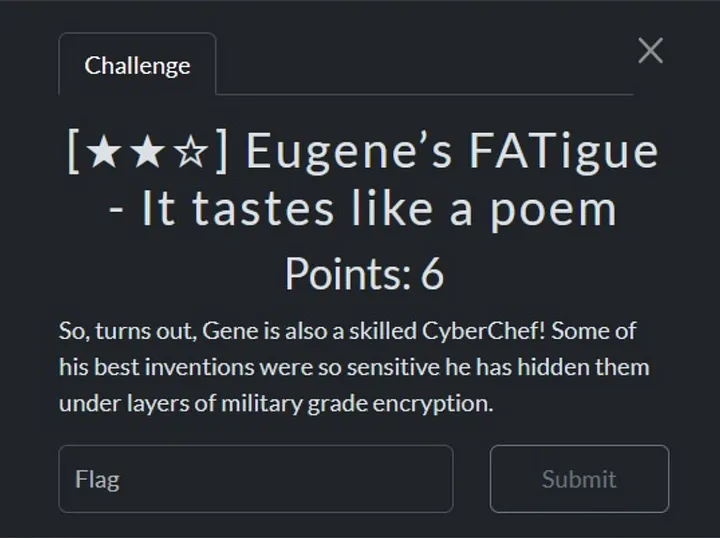
Solution
It seems the fourth-flag.aes.b64.txt is the file for this challenge.
I wrote forensics.py to assist in the decoding and so on,
import base64
from Crypto.Cipher import AES
# Load and decode the file
with open("fourth-flag.aes.b64.txt", "r") as f:
data = base64.b64decode(f.read().strip())
# Best working parameters from our tests
null_key = bytes(32) # 32 null bytes for AES-256
iv = data[:16] # First 16 bytes as IV
ciphertext = data[16:]
# Decrypt using AES-CBC
cipher = AES.new(null_key, AES.MODE_CBC, iv=iv)
decrypted = cipher.decrypt(ciphertext)
# Clean up padding and save full output
try:
# Remove PKCS#7 padding if present
pad_len = decrypted[-1]
if pad_len <= 16 and all(b == pad_len for b in decrypted[-pad_len:]):
decrypted = decrypted[:-pad_len]
# Save to file and print first 200 characters
with open("decrypted_poem.txt", "wb") as f:
f.write(decrypted)
print("Full decryption saved to decrypted_poem.txt")
print("\nFirst 200 characters:")
print(decrypted[:200].decode('utf-8', errors='replace'))
except Exception as e:
print("Error cleaning padding:", e)
print("Raw output (first 200 bytes):")
print(decrypted[:200])and it got the flag right away
The Results are as below cool and juicy!!!!!
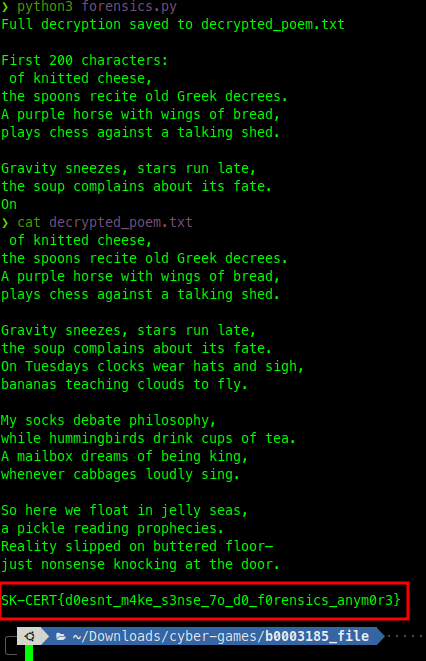
SK-CERT{d0esnt_m4ke_s3nse_7o_d0_f0rensics_anym0r3}Wrapping it up
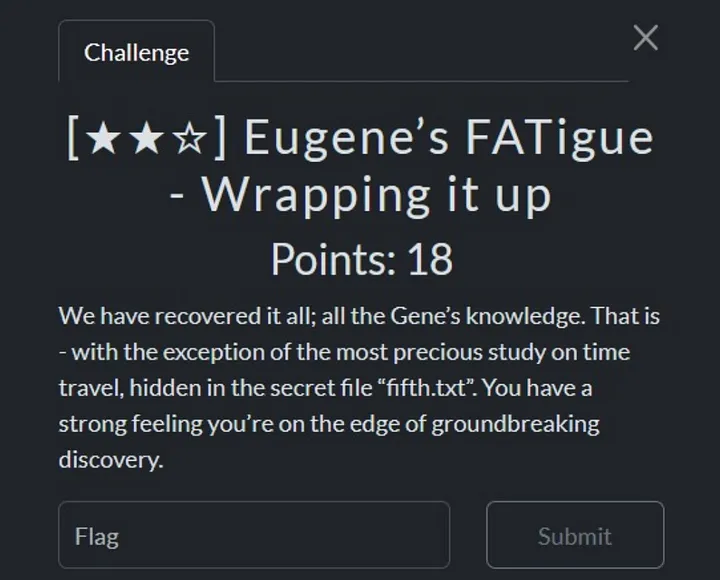
Solution
The fifth.txt contains the below text with the flag

SK-CERT{1mp0ss1bly_H4RD}
That was the flag for this challenge. It seems PhotoRec/TestDisk recovered enough mess after the ZIP or 7z did a good job to extract this anyway, not sure, to be honest.
thats it on the eugene fatigue now to the next challenge:
[★☆☆] The Chronicles of Greg 2 — Frustrating compression
On this challenge it was cold to me but a nigga gave me glasses to see it through though it was the last minute and the servers were down i coulnt submit the results but were correct after crawling though other writeups and in deed i was correct.that made me cool.enough with the crap lets dive in :
1. The Chronicles of Greg Frustrating compression
There was a lot of archives here, after fiddling with it manually for a minute or so, it quickly became clear that it was a no-go. I asked chat-gpt to help create a code several times and at long last i got it right with few tweaks it was ready to go…
extract.py
#!/usr/bin/env python3
import logging
import os
import shutil
import tarfile
import tempfile
import zipfile
import py7zr
import rarfile
START_ARCHIVE = '00114021.tar'
OUTPUT_DIR = '/tmp/out'
# Supported archive extensions
ARCHIVE_EXTENSIONS = ('.zip', '.tar', '.rar', '.7z')
os.makedirs(OUTPUT_DIR, exist_ok=True)
def is_archive(filename):
return filename.lower().endswith(ARCHIVE_EXTENSIONS)
def extract_archive(filepath, extract_to):
if filepath.endswith('.zip'):
with zipfile.ZipFile(filepath, 'r') as zf:
zf.extractall(extract_to)
elif filepath.endswith('.tar'):
with tarfile.open(filepath, 'r:*') as tf:
tf.extractall(extract_to, filter='tar')
elif filepath.endswith('.rar'):
with rarfile.RarFile(filepath) as rf:
rf.extractall(extract_to)
elif filepath.endswith('.7z'):
with py7zr.SevenZipFile(filepath, mode='r') as z:
z.extractall(extract_to)
else:
raise ValueError(f'Unsupported archive: {filepath}')
processed_archives = set()
def process_archive(filepath):
abs_path = os.path.abspath(filepath)
if abs_path in processed_archives:
logging.warning('Skipping already processed archive: %s', filepath)
else:
logging.debug('Extracting archive: %s', filepath)
processed_archives.add(abs_path)
with tempfile.TemporaryDirectory() as tmpdir:
try:
extract_archive(filepath, tmpdir)
except Exception:
logging.exception(f'Failed to extract {filepath}')
return
for root, _, files in os.walk(tmpdir):
for name in files:
full_path = os.path.join(root, name)
logging.debug('Found file: %s', full_path)
if is_archive(name):
logging.debug('Recursing into nested archive: %s', full_path)
process_archive(full_path)
print('.', end='', flush=True)
else:
rel_path = os.path.relpath(full_path, tmpdir)
out_path = os.path.join(OUTPUT_DIR, rel_path)
os.makedirs(os.path.dirname(out_path), exist_ok=True)
logging.debug('Copying non-archive file to output: %s', out_path)
shutil.copy2(full_path, out_path)
print('+', end='', flush=True)
if __name__ == '__main__':
process_archive(START_ARCHIVE)
print()just run the code and let magic and power do its work …to unpack it all, then just found the flag:…
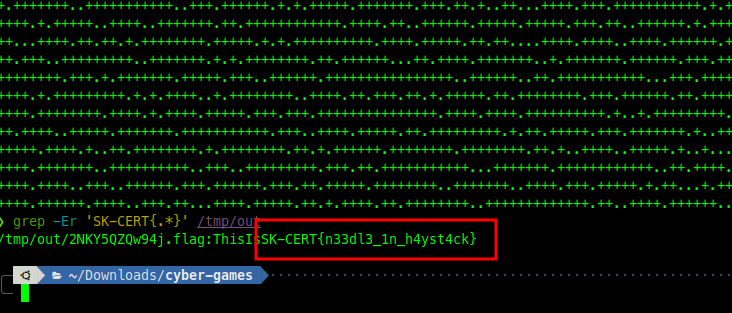
the next part was the most challenging part even with the glasses it was hard headed to me.i coundnt crack it but i will try to,,
hope you enjoyed the reading.Feel free to tag me.
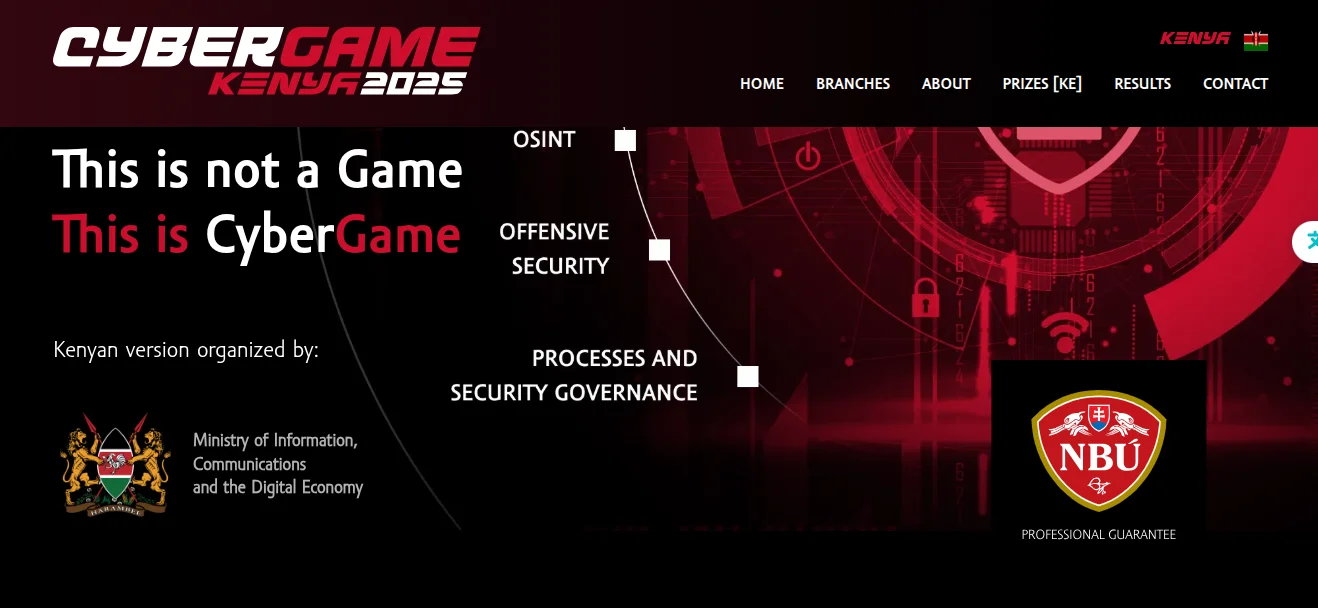
Comments